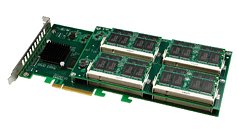- Joined
- Oct 9, 2007
- Messages
- 47,675 (7.43/day)
- Location
- Dublin, Ireland
| System Name | RBMK-1000 |
|---|---|
| Processor | AMD Ryzen 7 5700G |
| Motherboard | Gigabyte B550 AORUS Elite V2 |
| Cooling | DeepCool Gammax L240 V2 |
| Memory | 2x 16GB DDR4-3200 |
| Video Card(s) | Galax RTX 4070 Ti EX |
| Storage | Samsung 990 1TB |
| Display(s) | BenQ 1440p 60 Hz 27-inch |
| Case | Corsair Carbide 100R |
| Audio Device(s) | ASUS SupremeFX S1220A |
| Power Supply | Cooler Master MWE Gold 650W |
| Mouse | ASUS ROG Strix Impact |
| Keyboard | Gamdias Hermes E2 |
| Software | Windows 11 Pro |
OCZ Technology Group, Inc., a worldwide leader in innovative, ultra-high performance and high reliability memory and flash-based storage as an alternative to hard disk drives (HDDs), announces the Company's plan to enter mass production of the Z-Drive R2 Solid State Drive (SSD) Series, the second rendition of the original Z-Drive family. The Z-Drive R2 builds on the existing solution but provides greater performance and design flexibility due to the implementation of a series of optimized NAND modules.
"Our 4th generation PCIe SSD, the Z-Drive R2, tackles the performance challenges facing enterprise IT professionals head-on" said Ryan Petersen, CEO of the OCZ Technology Group. "The Z-Drive R2 is a total solution that delivers exceptional performance over a wide of range of applications due to its superior sequential performance, making it a winner in both high IOP and high-throughput environments. In addition, it is the only bootable and field serviceable PCIe SSD option on the market today, and due to an innovative interchangeable module design, it enables low cost field upgradability and capacity increases giving storage architects unprecedented flexibility."

The innovative Z-Drive R2 SSD maximizes bandwidth by taking the SATA bottleneck out of the equation and utilizes the speed advantages of the PCI-Express interface. Unlike competing solutions, the Z-Drive family is bootable and with 8 PCI-E lanes and an eight-way1 RAID 0 configuration, the R2 delivers performance ideal for enterprise applications that are limited by HDD technology. What also makes the R2 especially exceptional is the use of interchangeable modules in the place of permanent, surface-mounted NAND; this unique feature-set is designed to make the Z-Drive field-serviceable and field-upgradeable.
Addressing the emerging performance demands of storage area networks (SANs), workstations, and servers, the Z-Drive R2 creates new possibilities in enterprise data management. The R2 delivers extremely fast transfer rates up to 1.4 GB/s, while offering enhanced reliability and durability compared to mechanical hard drives.
Promoting greater productivity for a broad range of applications spanning across virtualization, caching, and high-end storage, the Z-Drive R2 can also provide cost savings when considering the total cost of ownership (TCO) versus complex and hard to maintain HDD infrastructures. With capacities ranging from 256GB to 2TB, the R2 makes SSDs a viable alternative to large, power-consuming hard drive arrays. Furthermore, OCZ offers customization options for OEM clients that may require tailored hardware or firmware solutions for their business.

View at TechPowerUp Main Site
"Our 4th generation PCIe SSD, the Z-Drive R2, tackles the performance challenges facing enterprise IT professionals head-on" said Ryan Petersen, CEO of the OCZ Technology Group. "The Z-Drive R2 is a total solution that delivers exceptional performance over a wide of range of applications due to its superior sequential performance, making it a winner in both high IOP and high-throughput environments. In addition, it is the only bootable and field serviceable PCIe SSD option on the market today, and due to an innovative interchangeable module design, it enables low cost field upgradability and capacity increases giving storage architects unprecedented flexibility."

The innovative Z-Drive R2 SSD maximizes bandwidth by taking the SATA bottleneck out of the equation and utilizes the speed advantages of the PCI-Express interface. Unlike competing solutions, the Z-Drive family is bootable and with 8 PCI-E lanes and an eight-way1 RAID 0 configuration, the R2 delivers performance ideal for enterprise applications that are limited by HDD technology. What also makes the R2 especially exceptional is the use of interchangeable modules in the place of permanent, surface-mounted NAND; this unique feature-set is designed to make the Z-Drive field-serviceable and field-upgradeable.
Addressing the emerging performance demands of storage area networks (SANs), workstations, and servers, the Z-Drive R2 creates new possibilities in enterprise data management. The R2 delivers extremely fast transfer rates up to 1.4 GB/s, while offering enhanced reliability and durability compared to mechanical hard drives.
Promoting greater productivity for a broad range of applications spanning across virtualization, caching, and high-end storage, the Z-Drive R2 can also provide cost savings when considering the total cost of ownership (TCO) versus complex and hard to maintain HDD infrastructures. With capacities ranging from 256GB to 2TB, the R2 makes SSDs a viable alternative to large, power-consuming hard drive arrays. Furthermore, OCZ offers customization options for OEM clients that may require tailored hardware or firmware solutions for their business.

View at TechPowerUp Main Site

 I want the 2TB Version
I want the 2TB Version  And my Harddrives could retire.
And my Harddrives could retire. 






